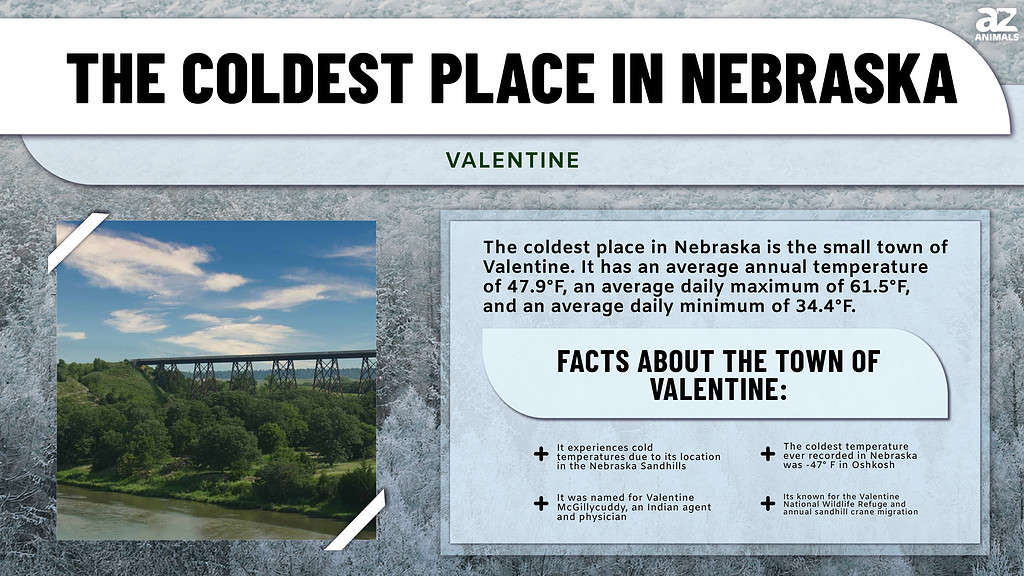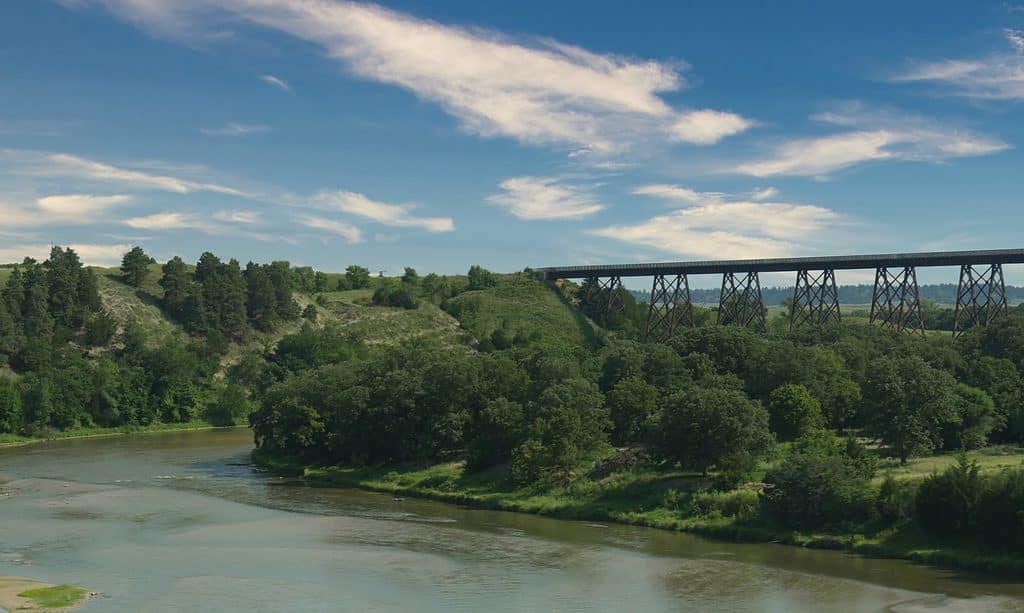
Nebraska may be known for its wide-open prairies and hot summers, but did you know that it’s also home to some of the coldest temperatures in the country? Nestled in the Great Plains region, Nebraska experiences extreme temperature swings and can get downright frigid in the winter. Today, we will explore the coldest place in Nebraska and learn about the unique weather patterns that shape this Midwestern state. Let’s get started!
The Coldest Place in Nebraska

Valentine is the coldest place in Nebraska.
©iStock.com/raksyBH
The coldest place in Nebraska is a small town named Valentine. It has an average annual temperature of 47.9°F, an average daily maximum of 61.5°F, and an average daily minimum of 34.4°F. It’s important to note that Valentine has the coldest average temperature of any town in the state, although some other places may have singular days that could be colder.
Valentine experiences cold temperatures due to its location in the Nebraska Sandhills, which are made up of vast expanses of sand dunes. These dunes can reach heights of up to 400 feet and contribute to the town’s cold climate.
The sandhills also suck up precipitation and stop the flow of moist air from the south. Additionally, the town’s location in the northern part of Nebraska also contributes to its colder temperatures, as it is farther away from the moderating influence of the Gulf of Mexico. Valentine’s unique geography and location make it the coldest town in Nebraska, with an average annual temperature of just 47.9°F.
The city was named for Valentine McGillycuddy, an Indian agent and physician. The city is known for its Valentine National Wildlife Refuge, which includes Lake Valentine, and for its annual sandhill crane migration, which draws many viewers in the spring. Incredibly, the Nebraska Sandhills are the most intact of all the temperate grasslands remaining in the world.
The Coldest Temperature Ever Recorded in Nebraska
The coldest temperature ever recorded in Nebraska was an absolutely frigid -47° F, which occurred in the town of Oshkosh on December 22, 1989. This was a dramatic contrast to the state’s all-time highest temperature of 118° F, which was recorded in Geneva on July 15, 1934.
This temperature difference of more than 160 degrees demonstrates the extreme temperature fluctuations that are possible in Nebraska, where the weather can be highly variable and unpredictable.
Despite these temperature extremes, Nebraska is home to a diverse range of ecosystems, from prairies and grasslands to forests and wetlands, and is home to a variety of plant and animal species.
Does it Snow in Nebraska?
Nebraska is known for its cold and snowy winters, with January being the coldest and snowiest month of the year. Average temperatures during this time can range from highs of 37 degrees Fahrenheit to lows of 12.5 degrees Fahrenheit, making it necessary to bundle up and stay warm.
Snowfall is also a common occurrence during this time, with the state recording an average of 6 inches of snow accumulation after 3.2 snowfall days. This can make it difficult to get around and enjoy outdoor activities, but it also adds a picturesque touch to the landscape. Despite the chill, Nebraska residents embrace the winter season and find ways to enjoy the colder weather.
The state isn’t generally known for its winter sports, but it’s important to remember that Nebraska shares a border with Wyoming to the west and South Dakota to the north; both places that are known for their unpredictable weather patterns!
How Animals Survive the Winters in Nebraska

Mountain lions
in Nebraska are well adapted to the cold winter temperatures.
©Chris Alcock/Shutterstock.com
Nebraska is home to a surprising array of wildlife, including rare species like mountain lions, bison, and the pronghorn. Each of these animals has adapted strategies to survive the freezing winters, each of them unique.
Mountain lions in Nebraska (a recent addition to the wildlife in the state) are well adapted to the cold winter temperatures. These cats have thick fur coats that help keep them warm in the cold, and they are able to maintain their body heat by conserving energy and staying active during the day. Mountain lions are also skilled hunters and are able to find prey even in the harshest of conditions, which helps them survive the winter months.
Bison in Nebraska are adapted to the cold winter weather in a number of ways. These massive animals have thick fur coats that help insulate them against the cold, and they are able to endure extreme temperatures thanks to their large size and thick layers of fat. Bison also have a unique way of dealing with deep snow: they use their heads to plow through the snow, creating pathways for other animals to follow.
Pronghorns in Nebraska have a number of adaptations that help them survive the cold winter months. These agile animals have fur coats that are able to insulate their bodies against the cold, and they are able to maintain their body heat by staying active and foraging for food.
Pronghorns are also able to tolerate extreme temperatures thanks to their large size and thick layers of fat, which help to keep them warm even in the harshest of conditions. Additionally, pronghorns migrate over 200 miles to different feeding grounds during the winter in order to avoid colder weather.
The photo featured at the top of this post is © iStock.com/Jacob Boomsma
Sources
- KEtV, Available here: https://www.ketv.com/article/nebraska-sandhills-most-intact-grasslands-remaining/39263694
- Does It Snow In, Available here: https://doesitsnowin.com/nebraska/#:~:text=Average%20temperatures%20in%20the%20state,millimetres)%20after%203.2%20snowfall%20days.
- National Oceanic and Atmospheric Administration, Available here: https://www.ncei.noaa.gov/
Thank you for reading! Have some feedback for us? Contact the AZ Animals editorial team.






